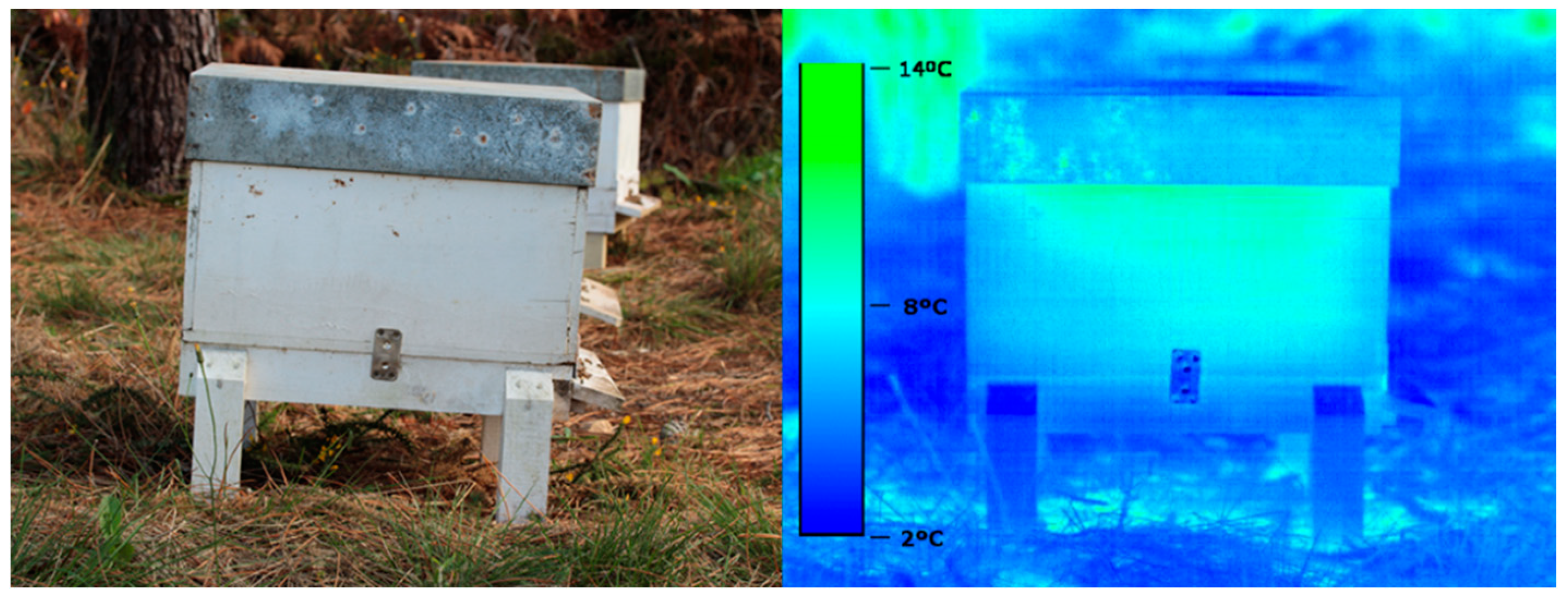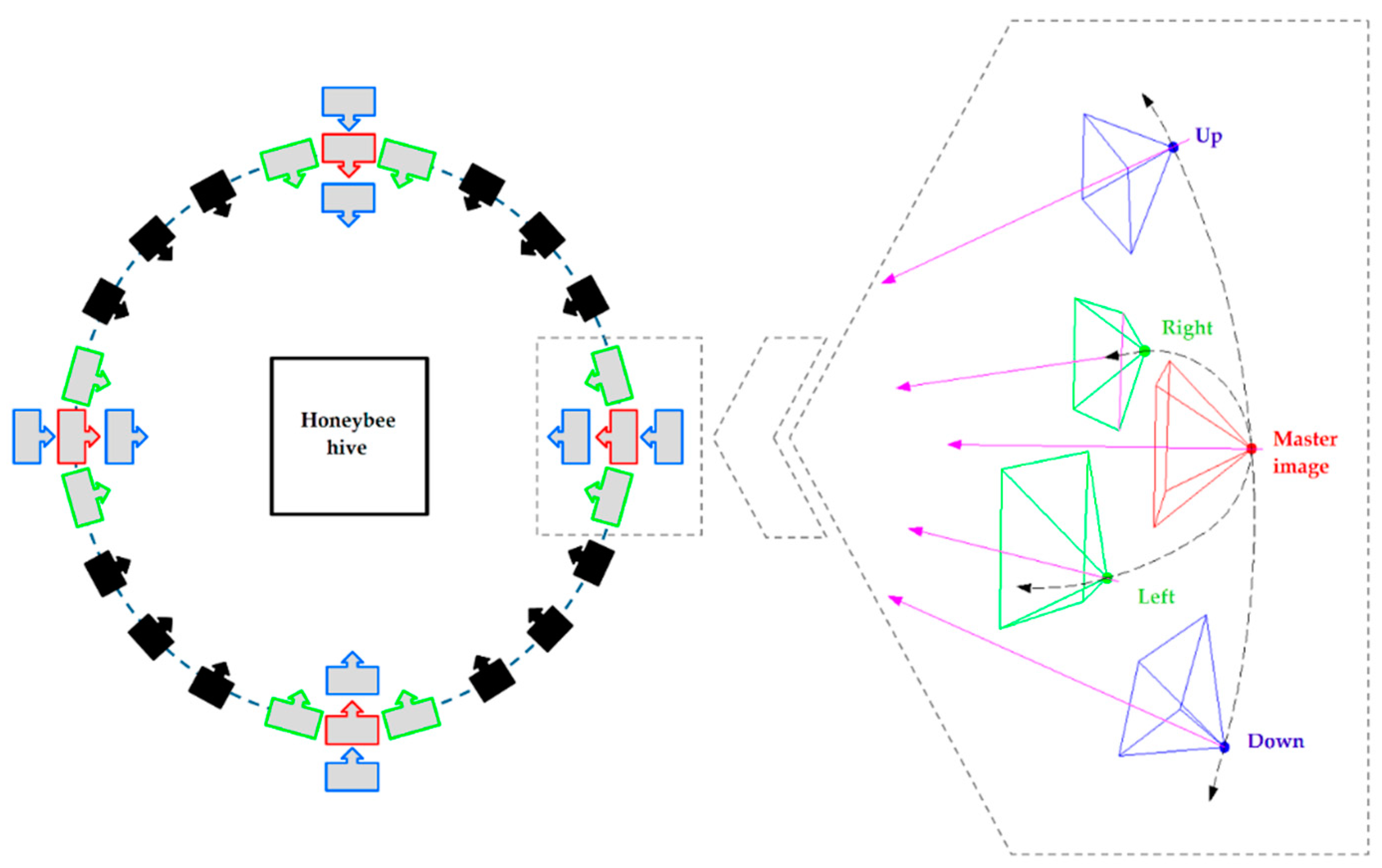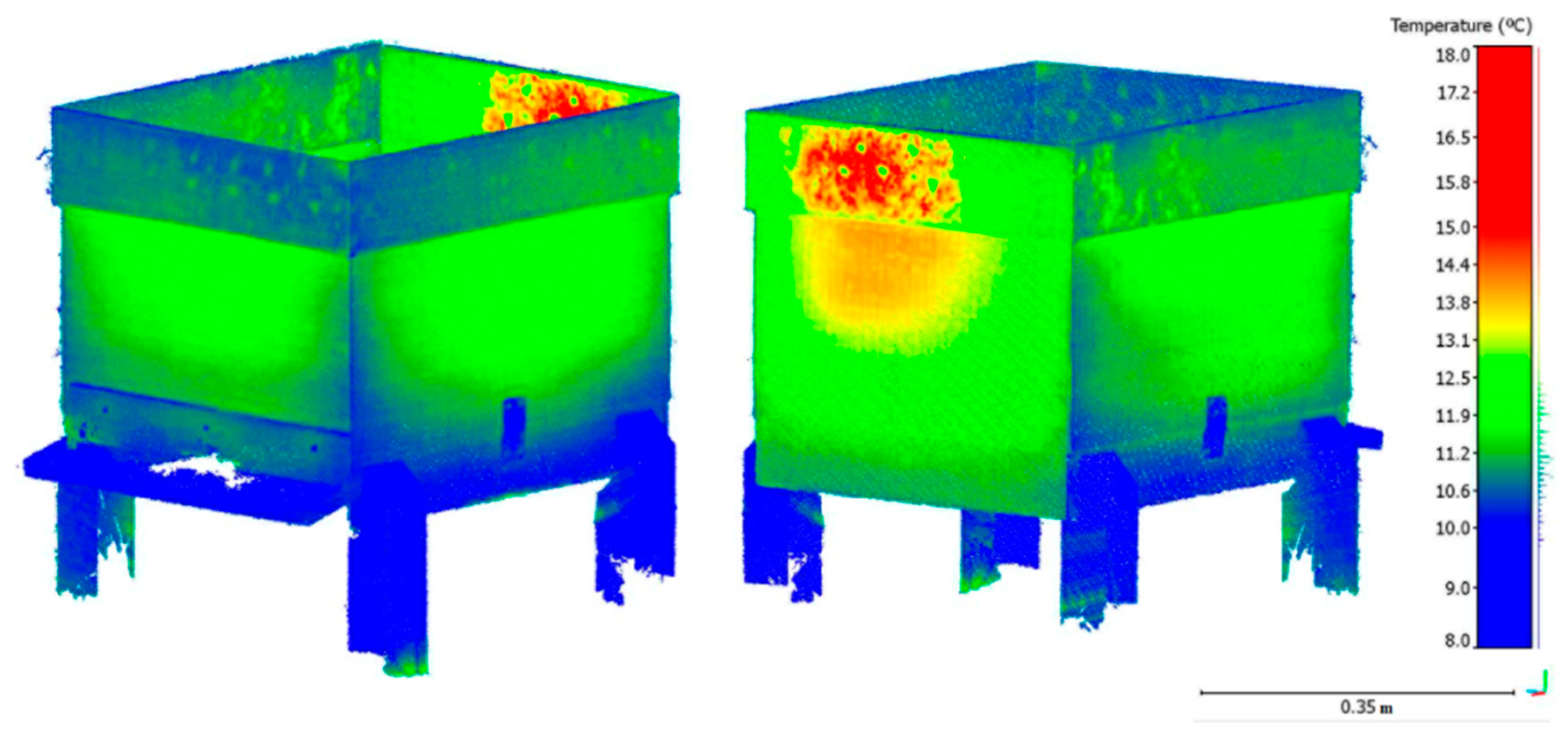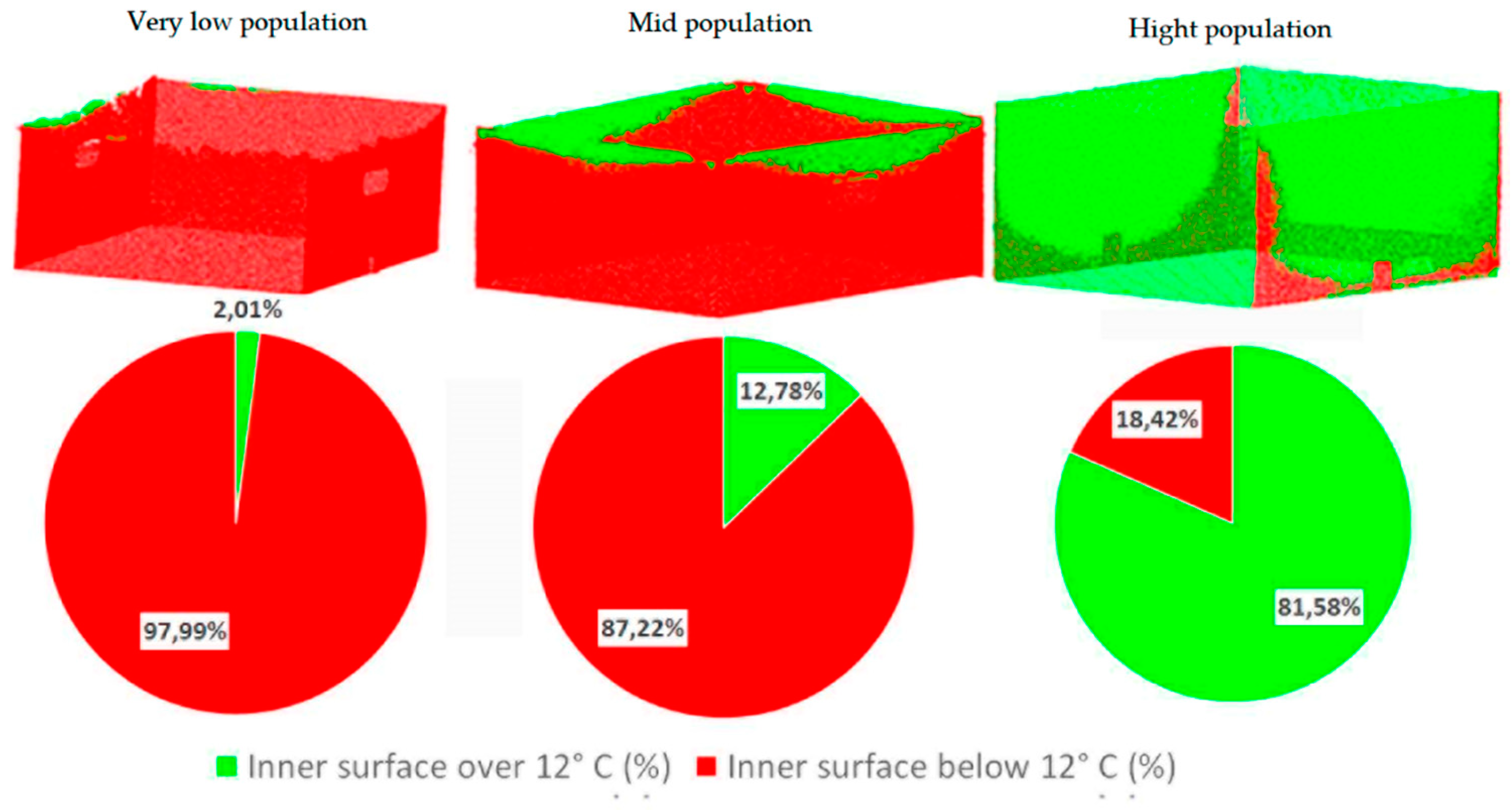Close-Range Photogrammetry and Infrared Imaging for Non-Invasive Honeybee Hive Population Assessment
Abstract
:1. Introduction
2. Materials and Methods
2.1. Equipment
2.1.1. RGB Camera
2.1.2. Thermal Data Acquisition
2.2. Methodology
2.2.1. Data Acquisition
2.2.2. 3D Point Cloud Reconstruction
2.2.3. Estimation of Interior Honeybee Hive Temperature
2.2.4. Geometric Preprocessing
2.2.5. Honeybee Hive Population Assessment
3. Experimental Results
Study Case
4. Conclusions
Author Contributions
Funding
Conflicts of Interest
References
- Ellis, J.D.; Evans, J.D.; Pettis, J. Colony losses, managed colony population decline, and Colony Collapse Disorder in the United States. J. Apic. Res. 2010, 49, 134–140. [Google Scholar] [CrossRef]
- Potts, S.G.; Roberts, S.P.; Dean, R.; Marris, G.; Brown, M.A.; Jones, R. Declines of managed honey bees and beekeepers in Europe. J. Apic. Res. 2010, 49, 15–22. [Google Scholar] [CrossRef]
- Kluser, S.; Neumann, P.; Chauzat, M.P.; Pettis, J.S.; Peduzzi, P.; Witt, R. Global Honey Bee Colony Disorders and Other Threats to Insect Pollinators; UNEP: Nairobi, Kenya, 2011. [Google Scholar]
- Berthoud, H.; Imdorf, A.; Haueter, M.; Radloff, S.; Neumann, P. Virus infections and winter losses of honey bee colonies (Apis mellifera). J. Apic. Res. 2010, 49, 60–65. [Google Scholar] [CrossRef]
- Carreck, N.L.; Ball, B.V.; Martin, S.J. The epidemiology of cloudy wing virus infections in honey bee colonies in the UK. J. Apic. Res. 2010, 49, 66–71. [Google Scholar] [CrossRef]
- Martin, S.J.; Ball, B.V.; Carreck, N.L. Prevalence and persistence of deformed wing virus (DWV) in untreated or acaricide-treated Varroa destructor infested honey bee (Apis mellifera) colonies. J. Apic. Res. 2010, 49, 72–79. [Google Scholar] [CrossRef]
- Carreck, N.L.; Ball, B.V.; Martin, S.J. Honey bee colony collapse and changes in viral prevalence associated with Varroa destructor. J. Apic. Res. 2010, 49, 93–94. [Google Scholar] [CrossRef]
- Paxton, R.J. Does infection by Nosema ceranae cause “Colony Collapse Disorder” in honey bees (Apis mellifera)? J. Apic. Res. 2010, 49, 80–84. [Google Scholar] [CrossRef]
- Santrac, V.; Granato, A.; Mutinelli, F. Detection of Nosema ceranae in Apis mellifera from Bosnia and Herzegovina. J. Apic. Res. 2010, 49, 100–101. [Google Scholar] [CrossRef]
- Higes, M.; Martín-Hernández, R.; Garrido-Bailón, E.; González-Porto, A.V.; García-Palencia, P.; Meana, A. Honeybee colony collapse due to Nosema ceranae in professional apiaries. Environ. Microbiol. Rep. 2009, 1, 110–113. [Google Scholar] [CrossRef] [PubMed]
- Dahle, B. The role of Varroa destructor for honey bee colony losses in Norway. J. Apic. Res. 2010, 49, 124–129. [Google Scholar] [CrossRef]
- Chauzat, M.P.; Martel, A.C.; Blanchard, P.; Clément, M.C.; Schurr, F.; Lair, C. A case report of a honey bee colony poisoning incident in France. J. Apic. Res. 2010, 49, 113–118. [Google Scholar] [CrossRef]
- Medrzycki, P.; Sgolastra, F.; Bortolotti, L.; Bogo, G.; Tosi, S.; Padovani, E. Influence of brood rearing temperature on honey bee development and susceptibility to poisoning by pesticides. J. Apic. Res. 2010, 49, 52–61. [Google Scholar] [CrossRef]
- Harz, M.; Müller, F.; Rademacher, E. Organic acids: Acute toxicity on Apis mellifera and recovery in the haemolymph. J. Apic. Res. 2010, 49, 95–101. [Google Scholar] [CrossRef]
- Meixner, M.D.; Costa, C.; Kryger, P.; Hatjina, F.; Bouga, M.; Ivanova, E. Conserving diversity and vitality for honey bee breeding. J. Apic. Res. 2010, 49, 85–92. [Google Scholar] [CrossRef]
- Monceau, K.; Bonnard, O.; Thiéry, D. Vespa velutina: A new invasive predator of honeybees in Europe. J. Pest. Sci. 2014, 87, 1–16. [Google Scholar] [CrossRef]
- Tan, K.; Radloff, S.; Li, J.; Hepburn, H.; Yang, M.; Zhang, L. Bee-hawking by the wasp, Vespa velutina, on the honeybees Apis cerana and A. mellifera. Naturwissenschaften 2007, 94, 469–472. [Google Scholar] [CrossRef] [PubMed]
- Villemant, C.; Barbet-Massin, M.; Perrard, A.; Muller, F.; Gargominy, O.; Jiguet, F. Predicting the invasion risk by the alien bee-hawking Yellow-legged hornet Vespa velutina nigrithorax across Europe and other continents with niche models. Biol. Conserv. 2011, 144, 2142–2150. [Google Scholar] [CrossRef]
- Kronfeld-Schor, N.; Bloch, G.; Schwartz, W. Animal clocks: When science meets nature. Proc. R. Soc. B Biol. Sci. 2013, 280, 20131354. [Google Scholar] [CrossRef] [PubMed]
- Majewski, J. Economic Value of Pollination of Major Crops in Poland in 2012. In Proceedings of the Economic Science for Rural Development Conference, Jelgava, Latvia, 25–26 April 2013. [Google Scholar]
- Williams, I. Aspects of Bee Diversity and Crop Pollination in the European Union; International Bee Research Association: Bristol, UK; Linnean Society of London: London, UK, 1996. [Google Scholar]
- Gallai, N.; Salles, J.M.; Settele, J.; Vaissière, B.E. Economic valuation of the vulnerability of world agriculture confronted with pollinator decline. Ecol. Econ. 2009, 68, 810–821. [Google Scholar] [CrossRef] [Green Version]
- González-Jorge, H.; Lagüela, S.; Krelling, P.; Armesto, J.; Martínez-Sánchez, J. Single image rectification of thermal images for geometric studies in façade inspections. Infrared Phys. Technol. 2012, 55, 421–426. [Google Scholar] [CrossRef]
- Turner, D.; Lucieer, A.; Malenovsky, Z.; King, D.; Robinson, S. Spatial co-registration of ultra-high resolution visible, multispectral and thermal images acquired with a micro-UAV over Antarctic Moss Beds. Remote Sens. 2014, 6, 4003–4024. [Google Scholar] [CrossRef]
- Lagüela, S.; Armesto, J.; Arias, P.; Herráez, J. Automation of thermographic 3D modelling through image fusion and image matching techniques. Autom. Constr. 2012, 27, 24–31. [Google Scholar] [CrossRef]
- Solla, M.; Lagüela, S.; Riveiro, B.; Lorenzo, H. Non-destructive testing for the analysis of moisture in the masonry arch bridge of Lubians (Spain). Struct. Control Health Monit. 2013, 20, 1366–1376. [Google Scholar] [CrossRef]
- Hastedt, H.; Luhmann, T. Investigations on the quality of the interior orientation and its impact in object space for UAV photogrammetry. Int. Arch. Photogramm. Remote Sens. Spat. Inf. Sci. 2015, 40, 321–328. [Google Scholar] [CrossRef]
- Gasparovic, M.; Gajski, D. Two-step camera calibration method developed for micro UAV’s. Int. Arch. Photogramm. Remote Sens. Spat. Inf. Sci. 2016, 41, 829–833. [Google Scholar] [CrossRef]
- Luhmann, T.; Fraser, C.; Maas, H. Sensor modelling and camera calibration for close-range photogrammetry. ISPRS J. Photogramm. Remot. Sens. 2016, 115, 37–46. [Google Scholar] [CrossRef]
- Lagüela, S.; González-Jorge, H.; Armesto, J.; Arias, P. Calibration and verification of thermographic cameras for geometric measurements. Inf. Phys. Technol. 2011, 54, 92–99. [Google Scholar] [CrossRef]
- Lagüela, S.; González-Jorge, H.; Armesto, J.; Herráez, J. High performance grid for the metric calibration of thermographic cameras. Meas. Sci. Technol. 2012, 23, 015402. [Google Scholar] [CrossRef]
- González-Jorge, H.; Riveiro, B.; Armesto, J.; Arias, P. Verification artifact for photogrammetric measurement systems. Opt. Eng. 2011, 50, 073603. [Google Scholar] [CrossRef]
- Tait, D. Photogrammetry, Vol. 1. Fundamentals and Standard Processes: Karl Kraus; Ferdinand Dümmels: Bonn, Germany, 1993; p. 402. ISBN 3-427-78681-1. [Google Scholar]
- Agarwal, S.; Furukawa, Y.; Snavely, N.; Simon, I.; Curless, B.; Seitz, S.M. Building Rome in a day. Commun. ACM 2011, 54, 105–112. [Google Scholar] [CrossRef]
- Balaras, C.; Argiriou, A. Infrared thermography for building diagnostics. Energy Build. 2002, 34, 171–183. [Google Scholar] [CrossRef]
- Lagüela, S.; Díaz-Vilariño, L.; Martínez, J.; Armesto, J. Automatic thermographic and RGB texture of as-built BIM for energy rehabilitation purposes. Autom. Constr. 2013, 31, 230–240. [Google Scholar] [CrossRef]
- Gonzalez-Aguilera, D.; López-Fernández, L.; Rodriguez-Gonzalvez, P.; Guerrero, D.; Hernandez-Lopez, D.; Remondino, F.; Menna, F.; Nocerino, E.; Toschi, I.; Ballabeni, A.; Gaiani, M. GRAPHOS–open-source software for photogrammetric applications. Photogramm. Rec. 2018, 33, 11–29. [Google Scholar] [CrossRef]
- Lowe, D.G. Object recognition from local scale-invariant features. Comput. Vis. 1999, 2, 1150–1157. [Google Scholar]
- Morel, J.M.; Yu, G. ASIFT: A new framework for fully affine invariant image comparison. SIAM J. Imaging Sci. 2009, 2, 438–469. [Google Scholar] [CrossRef]
- Longuet-Higgins, H.C. A computer algorithm for reconstructing a scene from two projections. In Readings in Computer Vision: Issues, Problems, Principles, and Paradigms; Fischler, M.A., Firschein, O., Eds.; Morgan Kaufmann Publishers, Inc.: Los Altos, CA, USA, 1987; pp. 61–63. [Google Scholar]
- Deseilligny, M.P.; Clery, I. Apero, an open source bundle adjusment software for automatic calibration and orientation of set of images. Int. Arch. Photogramm. Remote Sens. Spat. Inf. Sci. 2011, 38, 269–276. [Google Scholar] [CrossRef]
- Luhmann, T.; Robson, S.; Kyle, S.; Harley, I. Close Range Photogrammetry: Principles, Methods and Applications; Whittles: Scotland, UK, 2006. [Google Scholar]
- Rothermel, M.; Wenzel, K.; Fritsch, D.; Haala, N. SURE: Photogrammetric surface reconstruction from imagery. Proc. LC3D Workshop Berl. 2012, 8, 2. [Google Scholar]
- Kraus, K.; Jansa, J.; Kager, K. Advanced Methods and Applications. Vol. 2. Fundamentals and Estándar Processes. Vol. 1; Institute for Photogrammetry, Vienna University of Technology: Vienna, Austria; Ferd Dummler: Bonn, Germany, 1993. [Google Scholar]
- Shih, T.; Faig, W. A solution for space resection in closed form. Int. Arch. Photogramm. Remote Sens. Spat. Inf. Sci. 1988, 27, 547–556. [Google Scholar]
- Norton, J. The Logical Inconsistency of the Old Quantum Theory of Black Body Radiation. Philos. Sci. 1987, 54, 327–350. [Google Scholar] [CrossRef]
- Lagüela, S.; Díaz-Vilariño, L.; Roca, D. Infrared Thermography: Fundamentals and Applications. In Non-Destructive Techniques for the Evaluation of Infrastructures; CRC Press: Boca Raton, FL, USA, 2016; pp. 113–138. [Google Scholar]
- Lagüela, S.; Díaz-Vilariño, L.; Armesto, J.; Arias, P. Non-destructive approach for the generation and thermal characterization of an as-built BIM. Constr. Build. Mater. 2014, 51, 55–61. [Google Scholar] [CrossRef]
- ISO 6946:2007. Building Components and Building Elements—Thermal Resistance and Thermal Transmittance—Calculation Method. Available online: https://www.iso.org/standard/40968.html (accessed on 6 August 2018).
- Rusu, R.B.; Cousins, S. 3D is here: Point Cloud Library (PCL). In Proceedings of the 2011 IEEE International Conference on Robotics and Automation (ICRA), Shanghai, China, 9–13 May 2011. [Google Scholar]
- AFSSA. Weakening, Collapse and Mortality of Bee Colonies. 2008. Available online: http://www.uoguelph.ca/canpolin/Publications/AFSSA%20Report%20SANT-Ra-MortaliteAbeillesEN.pdf (accessed on 6 August 2018).
- Free, J.; Spencer-Booth, Y. Observations on the temperature regulation and food consumption of honeybees (Apis mellifera). J. Exp. Biol. 1958, 35, 930–937. [Google Scholar]
- Shaw, J.A.; Nugent, P.W.; Johnson, J.; Bromenshenk, J.J.; Henderson, C.B.; Debnam, S. Long-wave infrared imaging for non-invasive beehive population assessment. Opt. Express 2011, 19, 399–408. [Google Scholar] [CrossRef] [PubMed]










| Parameter | Value | |
|---|---|---|
| Focal length, (mm) | Value | 64.214 |
| Format size (mm × mm) | Value | 24.746 × 15.164 |
| Principal point (mm) | X value | 11.392 |
| Y value | 7.736 | |
| Radial lens distortion | K1 value (mm−1) | 9.498 × 10−6 |
| K2 value (mm−3) | −3.350 × 10−8 | |
| Decentering lens distortion | P1 value (mm−1) | −1.772 × 10−7 |
| P2 value (mm−1) | 8.263 × 10−8 | |
| Point marking residuals | Overall RMSE (pixels) | 0.171 |
| Parameter | Value | |
|---|---|---|
| Focal length, (mm) | Value | 15.222 |
| Format size (mm × mm) | Value | 6.000 × 4.500 |
| Principal point (mm) | X value | 2.977 |
| Y value | 2.140 | |
| Radial lens distortion | K1 value (mm−1) | 1.158 × 10−3 |
| K2 value (mm−3) | −3.859 × 10−5 | |
| K3 value (mm−5) | 2.619 × 10−6 | |
| Decentering lens distortion | P1 value (mm−1) | 2.733 × 10−5 |
| P2 value (mm−1) | −2.413 × 10−5 |
| Parameter | Value |
|---|---|
| Range | −50 °C to 150 °C |
| Accuracy | ±0.2 °C (−25 °C to +40 °C) |
| ±0.3 °C (+40.1 °C to +80 °C) | |
| ±0.4 °C (+80.1 °C to +125 °C) | |
| ±0.5 °C (<25 °C and >125 °C) | |
| Resolution | 0.1 °C |
© 2018 by the authors. Licensee MDPI, Basel, Switzerland. This article is an open access article distributed under the terms and conditions of the Creative Commons Attribution (CC BY) license (http://creativecommons.org/licenses/by/4.0/).
Share and Cite
López-Fernández, L.; Lagüela, S.; Rodríguez-Gonzálvez, P.; Martín-Jiménez, J.A.; González-Aguilera, D. Close-Range Photogrammetry and Infrared Imaging for Non-Invasive Honeybee Hive Population Assessment. ISPRS Int. J. Geo-Inf. 2018, 7, 350. https://doi.org/10.3390/ijgi7090350
López-Fernández L, Lagüela S, Rodríguez-Gonzálvez P, Martín-Jiménez JA, González-Aguilera D. Close-Range Photogrammetry and Infrared Imaging for Non-Invasive Honeybee Hive Population Assessment. ISPRS International Journal of Geo-Information. 2018; 7(9):350. https://doi.org/10.3390/ijgi7090350
Chicago/Turabian StyleLópez-Fernández, Luis, Susana Lagüela, Pablo Rodríguez-Gonzálvez, José Antonio Martín-Jiménez, and Diego González-Aguilera. 2018. "Close-Range Photogrammetry and Infrared Imaging for Non-Invasive Honeybee Hive Population Assessment" ISPRS International Journal of Geo-Information 7, no. 9: 350. https://doi.org/10.3390/ijgi7090350








